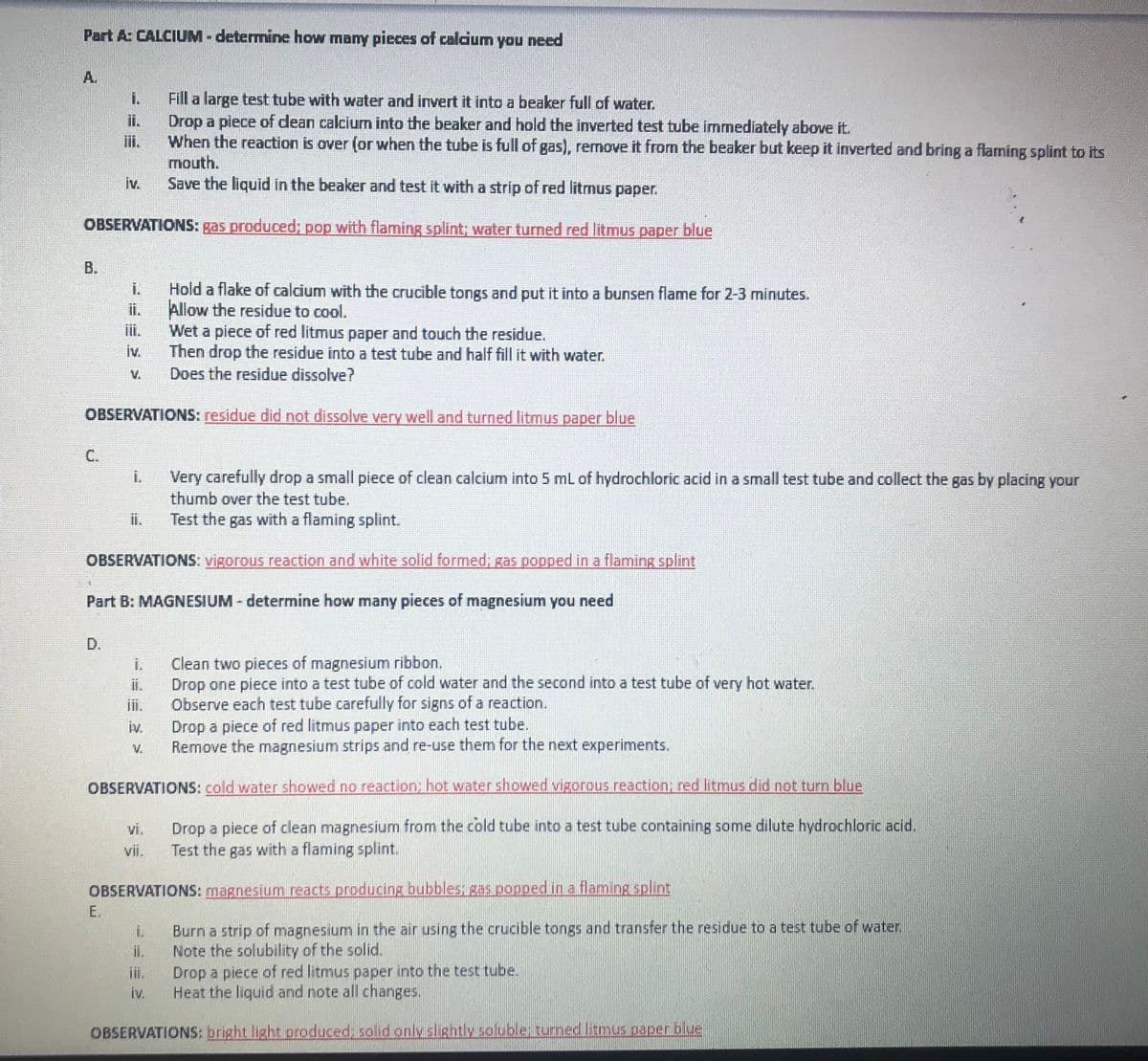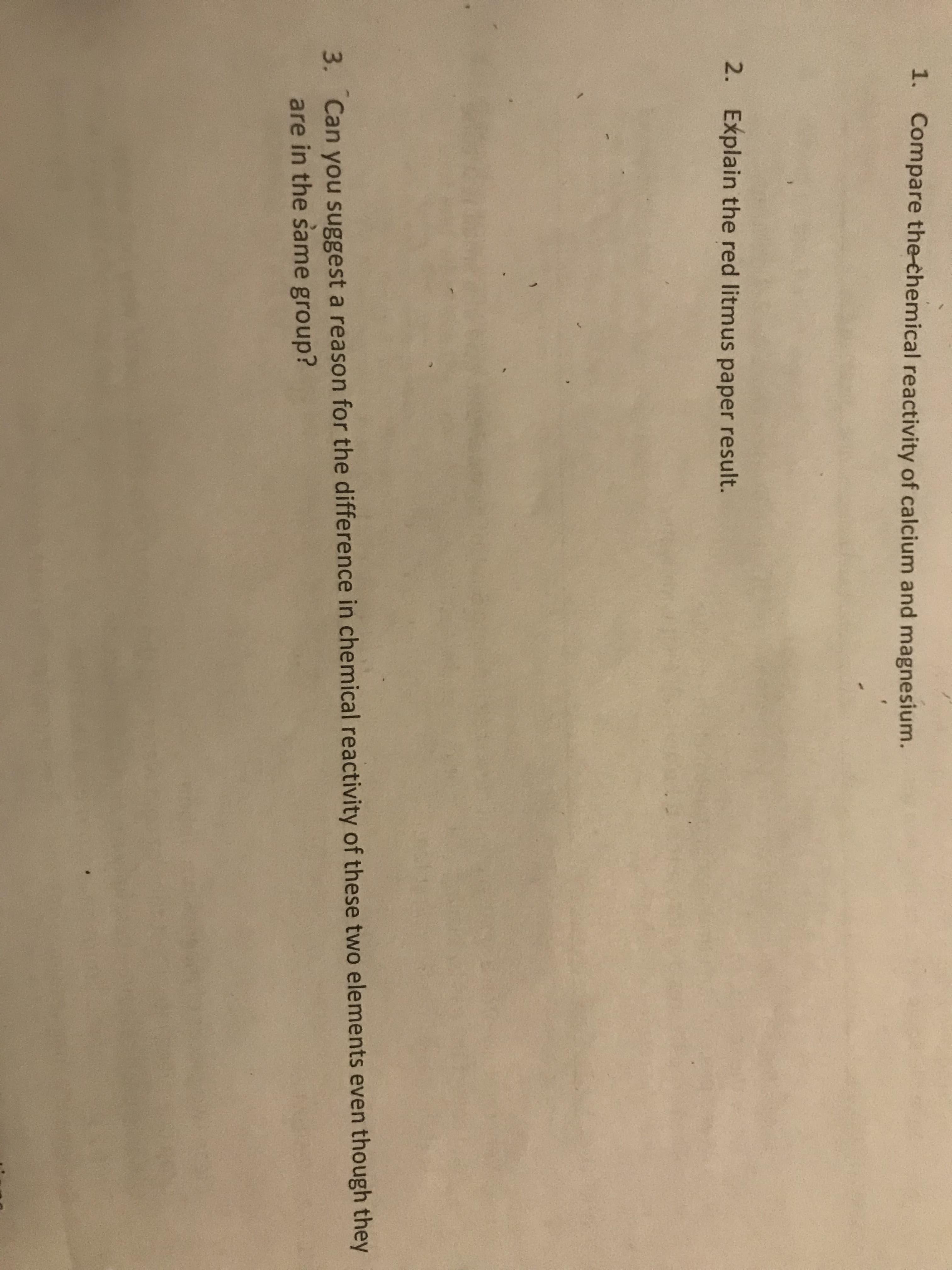1. Compare the-chemical reactivity of calcium and magnesium.
Database System Concepts
7th Edition
ISBN:9780078022159
Author:Abraham Silberschatz Professor, Henry F. Korth, S. Sudarshan
Publisher:Abraham Silberschatz Professor, Henry F. Korth, S. Sudarshan
Chapter1: Introduction
Section: Chapter Questions
Problem 1PE
Related questions
Question
Please help
Please indicate the question you are doing

Transcribed Image Text:Part A: CALCIUM - determine how mamy pieces of calcium
need
A.
Fill a large test tube with water and invert it into a beaker full of water.
Drop a piece of dean calcium into the beaker and hold the inverted test tube immediately above it.
When the reaction is over (or when the tube is full of gas), remove it from the beaker but keep it inverted and bring a flaming splint to its
mouth.
Save the liquid in the beaker and test it with a strip of red litmus paper.
i.
ii.
iii.
iv.
OBSERVATIONS: gas produced; pop with flaming splint; water turned red litmus paper blue
В.
Hold a flake of calcium with the crucible tongs and put it into a bunsen flame for 2-3 minutes.
Allow the residue to cool.
Wet a piece of red litmus paper and touch the residue.
Then drop the residue into a test tube and half fill it with water.
Does the residue dissolve?
i.
ii.
ii.
iv.
OBSERVATIONS: residue did not dissolve very well and turned litmus paper blue
C.
Very carefully drop a small piece of clean calcium into 5 mL of hydrochloric acid in a small test tube and collect the gas by placing your
thumb over the test tube,
ii.
i.
Test the gas with a flaming splint.
OBSERVATIONS: vigorous reaction and white solid formed; gas popped in a flaminR splint
Part B: MAGNESIUM - determine how many pieces of magnesium you need
D.
Clean two pieces of magnesium ribbon.
Drop one piece into a test tube of cold water and the second into a test tube of very hot water.
Observe each test tube carefully for signs of a reaction.
Drop a piece of red litmus paper into each test tube.
Remove the magnesium strips and re-use them for the next experiments.
i.
iv.
V.
OBSERVATIONS: cold water showed no reaction; hot water showed vigorous reaction; red litmus did not turn blue
Vi.
Drop a piece of clean magnesium from the cold tube into a test tube containing some dilute hydrochloric acid.
vii.
Test the gas with a flaming splint.
OBSERVATIONS: magnesium reacts producing bubbles: gas popped in a flaming splint
E.
Burn a strip of magnesium in the air using the crucible tongs and transfer the residue to a test tube of water.
ii.
Note the solubility of the solid.
Drop a piece of red litmus paper into the test tube.
Heat the liquid and note all changes.
iv.
OBSERVATIONS: bright light produced, solidonly slightly soluble: turned litmus paper blue
B.

Transcribed Image Text:1. Compare the-chemical reactivity of calcium and magnesium.
2. Explain the red litmus paper result.
3. Can you suggest a reason for the difference in chemical reactivity of these two elements even though they
are in the same group?
Expert Solution
This question has been solved!
Explore an expertly crafted, step-by-step solution for a thorough understanding of key concepts.
Step by step
Solved in 3 steps

Knowledge Booster
Learn more about
Need a deep-dive on the concept behind this application? Look no further. Learn more about this topic, computer-science and related others by exploring similar questions and additional content below.Recommended textbooks for you

Database System Concepts
Computer Science
ISBN:
9780078022159
Author:
Abraham Silberschatz Professor, Henry F. Korth, S. Sudarshan
Publisher:
McGraw-Hill Education

Starting Out with Python (4th Edition)
Computer Science
ISBN:
9780134444321
Author:
Tony Gaddis
Publisher:
PEARSON

Digital Fundamentals (11th Edition)
Computer Science
ISBN:
9780132737968
Author:
Thomas L. Floyd
Publisher:
PEARSON

Database System Concepts
Computer Science
ISBN:
9780078022159
Author:
Abraham Silberschatz Professor, Henry F. Korth, S. Sudarshan
Publisher:
McGraw-Hill Education

Starting Out with Python (4th Edition)
Computer Science
ISBN:
9780134444321
Author:
Tony Gaddis
Publisher:
PEARSON

Digital Fundamentals (11th Edition)
Computer Science
ISBN:
9780132737968
Author:
Thomas L. Floyd
Publisher:
PEARSON

C How to Program (8th Edition)
Computer Science
ISBN:
9780133976892
Author:
Paul J. Deitel, Harvey Deitel
Publisher:
PEARSON

Database Systems: Design, Implementation, & Manag…
Computer Science
ISBN:
9781337627900
Author:
Carlos Coronel, Steven Morris
Publisher:
Cengage Learning

Programmable Logic Controllers
Computer Science
ISBN:
9780073373843
Author:
Frank D. Petruzella
Publisher:
McGraw-Hill Education